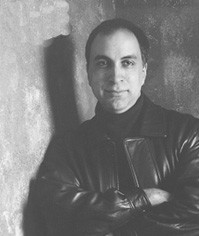
Composer Anthony Cornicello (born in Brooklyn, New York, 1964) writes music that blurs distinctions between performers and electronics, timbre and harmony, composition and improvisation, and explores the boundaries of what may be considered post-classical concert music. His music is vibrant and visceral, full of rhythmic energy and harmonic sophistication, and his forays into live electronics have led to exciting combinations of instruments and processed sound. Cornicello’s background as a jazz pianist is evident not only in the rhythmic activity of his music, but also in his constant investigation of the rich sonorities available from a variety of instruments.
He has been commissioned to write music for the Scorchio Electric String Quartet, ModernWorks! (funding from Meet the Composer/ Commissioning Music USA), the Auros Group for New Music, the Prism Saxophone Quartet, the New York New Music Ensemble, David Holzman, the Group for Contemporary Music, and the InterEnsemble of Padova, Italy. His work has also been featured on the Guggenheim Museum’s “Works and Process” series. Cornicello’s works have also been performed by the Chicago Civic Symphony, Parnassus, ALEA III, Composers Concordance, Madeleine Shapiro, Robert Black, among many other outstanding groups and solo performers. His music has been presented as part of the Darmstadt International Festival of New Music as well as the June in Buffalo Festival.
Cornicello’s Second String Quartet has been recorded by the Atlantic String Quartet; the Second Sonata for Piano by David Holzman (Centaur). More recently, his Post-Modern Waltz was recorded by Eric Moe for Albany Records. A portrait CD of Cornicello’s works is scheduled for 2006 release on Albany Records.
As a performer, he has conducted or played piano in his own works on numerous occasions. While a graduate student at Rutgers, he formed and directed the Janus Ensemble, a group dedicated to contemporary music. More recently, Cornicello has begun performing on the laptop, using a variety of interfaces and the Max/MSP program. Those performances, mostly with EEE!, have had a notable impact on his music, as EEE!’s music ranges from hip-hop to experimental noise. EEE! is based at Eastern Connecticut State University, where Cornicello is an Associate Professor and Director of the Electronic Music Lab.
Cornicello received the Ph.D. from Brandeis University, where he studied with David Rakowski, Eric Chasalow, and Martin Boykan. His teachers also include Charles Wuorinen, Gérard Grisey, and Richard Beirach.
His current fields of interest include developing unusual interfaces for live computer music performances, as well as continuing to investigate resonance and spatialization. His recent and current projects (mostly for string instruments and electronics) have been exploring the latter two, and the series of experimental works ReZenant Garden, performed by EEE! have operated on all three areas of interest. Future projects will include works for instrumental groups or soloists and electronics, as well as turntablists.
Cornicello's works are published by C.F. Peters Corporation and APNM, and he is a member of BMI.
|
|
|
|
|
|

Sunday, October 14, 2007
Open Music
Looks like I'm actually writing a piece using Open Music.
I've had this software from IRCAM for some time. And I've played with it - going through the tutorials, learning the logic behind the programming. (Okay, I've got to review their looping and recursion design, not to mention the odd way they use IF...THEM statements!) Basically, I think I understand how it's done.
During the time I've had the program, I've used it for some basic things: harmonic series generation, some basic harmonic progressions. But this time, I'd like to be able to use it to generate a lot more surface material - actual chords, spaced in time. Of course, I'll go through and work out more details, and most likely make some changes as I go along, but it's still an interesting process. For what it's worth, I'm using it to generate a series of chords that interpolate between two chords (one low on the piano, and one mid-range); then, I'm taking the results and processing them further. From there, I'm going to apply some basic rhythmic structures.
The interesting thing is that it's easy to change your mind. Rather than 'start over', you can plug in different opening and/or ending chords. The new material will be subjected to the same processes as above. But, rather than crumbling up paper, or erasing, and then rewriting, with the click of a mouse, I'm back in the game. Okay, sitting at the computer takes a lot more time than that, but you know what I mean.
Who's made use of this program, or anything else like it? Anyone try Composers Desktop Project? Anyone remember SoundGlobs?
posted by Anthony Cornicello
|
| |



